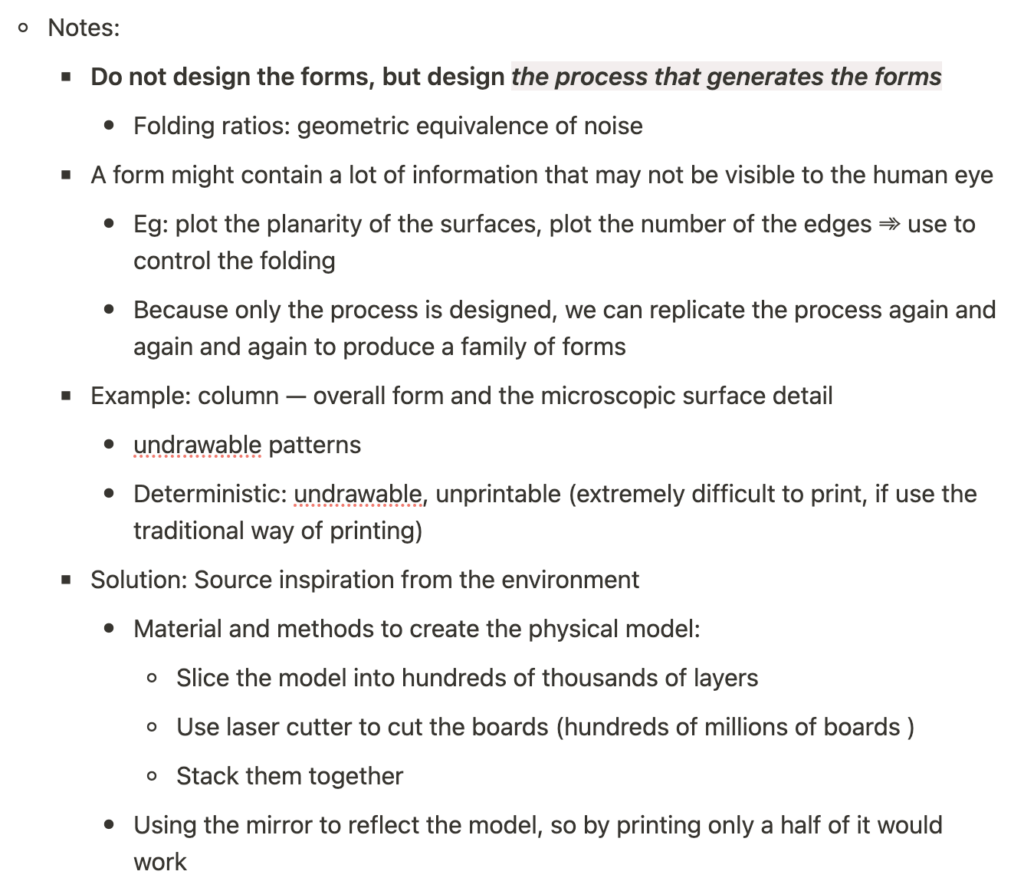Reflection on the TED talk & Guest Speaker’s talk 🤔️
- In this TED talk, the speaker gives insight of designing the process that generates the form, instead of the form. There are a few benefits of designing the process:
- It enables the embedment of data that can’t be perceived directly by human eyes
- It enables the designer to replicate the process: as long as the designer has a process, they can always embed different data and generate different forms. In this way a family of forms can be created
- Another inspiring idea he shares is about how to bring the computer modelings into physical forms. In the example he gives, the columns are almost unprintable because of the intricate modeling. However, the team sliced the modeling and used laser cutter, and afterwards stacked all of the boards together to make one model. They also used mirrors in another set of physicalization so that they only need to print a half of the modeling.
- I think I experience the similar thing when making printing choices for my project 1: the materials, the patterns of printing matters. The speaker also suggests that we can source inspirations from the nature world
- As for the take-aways from our guest speakers talk, what left me with the deepest impression is that be critical about your data. The data you use might be incomplete because of the dates included. When you have doubts about your data, try to research more and dig deep, so as to ensure the understanding and application of the data are correct.

Reflection on Readings 📖
- thoughts while reading:
- Working with parameters gives you infinite possibilities of different designs. It reminds me of coding in p5.js (umm, probably the arrays and the random variables)
- About RANDOMNESS:
- The readings shed light on my understanding of randomness: sometime I like the randomness because I want to see unexpected things. However, in my previous experiences, I could never explain the randomness. The embedment of randomness should be a combination of conscious choices made by artists/ designers themselves and choices out of their control. It is essential to make sense of the design. (On the other hand, I do think nothing is absolute. Maybe sometimes the explanation of the randomness is simple: I just want to experiment with the randomness. :DDD)
- Interesting insight: “Sequences of random numbers can be generated in such a way that each number in the sequence differs only slightly from the last”. When speaking of randomness or permutations of the original model/ design, I am always seeking after big, very conspicuous changes. But slight changes matter as well!
DEFINITIONs
- Parameter: a value that has an effect on the output of a process; it describes, encodes, and quantifies the options and constraints at play in a system (I’ve never really thought abt the constraints before!)
- Parameterization: Identify and describe the variable elements in a process
- decide what can change and the range of possible values for each parameter
- it creates connections between the intention of the designer and the system he or she is describing
- repetition (explore possible variations) and transformation (parameters’ effect on form); visualization and stimulation (describe how data or other inputs will influence the behavior of the system)
- Variable: The changeable parameters
- Sometimes variables make sense only in a certain range, a range can be refined to produce a narrower, but more pleasing field of variations.
PARAMETER TECHNIQUEs
-
- One-of-One: works as a singlar piece but provide a window into the complexity of the system (generate variations while preserving family resemblances)
- Variable Fonts
- Console: a set of controls for electronic or mechanical equipment
- Values controlled through a software console are linked to variables within the program; allow the state of the program to change without rewriting the code
- Can make the project more interactive by allowing users to change the parameters
Leave a Reply